Negotiation Reflection: Analysis of Negotiation Styles and Skills
VerifiedAdded on 2022/12/20
|7
|1656
|80
Report
AI Summary
This report is a comprehensive reflection on a student's negotiation capabilities, detailing their use of both collaborative and competing negotiation styles. The student emphasizes the importance of negotiation for achieving mutually beneficial agreements, highlighting the application of principles such as BETNA (Best Alternative to a Negotiated Agreement), compromise, and log-rolling within a collaborative framework. Evidence from personal experiences, including scenarios involving classmates, siblings, and business cases (e.g., Les Flores), illustrates the practical application of these strategies. The report also explores the competing style, emphasizing the zero-sum game, win-lose concepts, and the expansion of the pie to resolve stalemates. The student acknowledges the need for preparation, substance, and flexibility to be a successful negotiator, and concludes with a vision of becoming an ideal negotiator whose skills benefit others. Appendices provide details of different negotiation cases, including vacation plans, liquor business, summer intern programs, Kuku Nuts, and Les Flores.
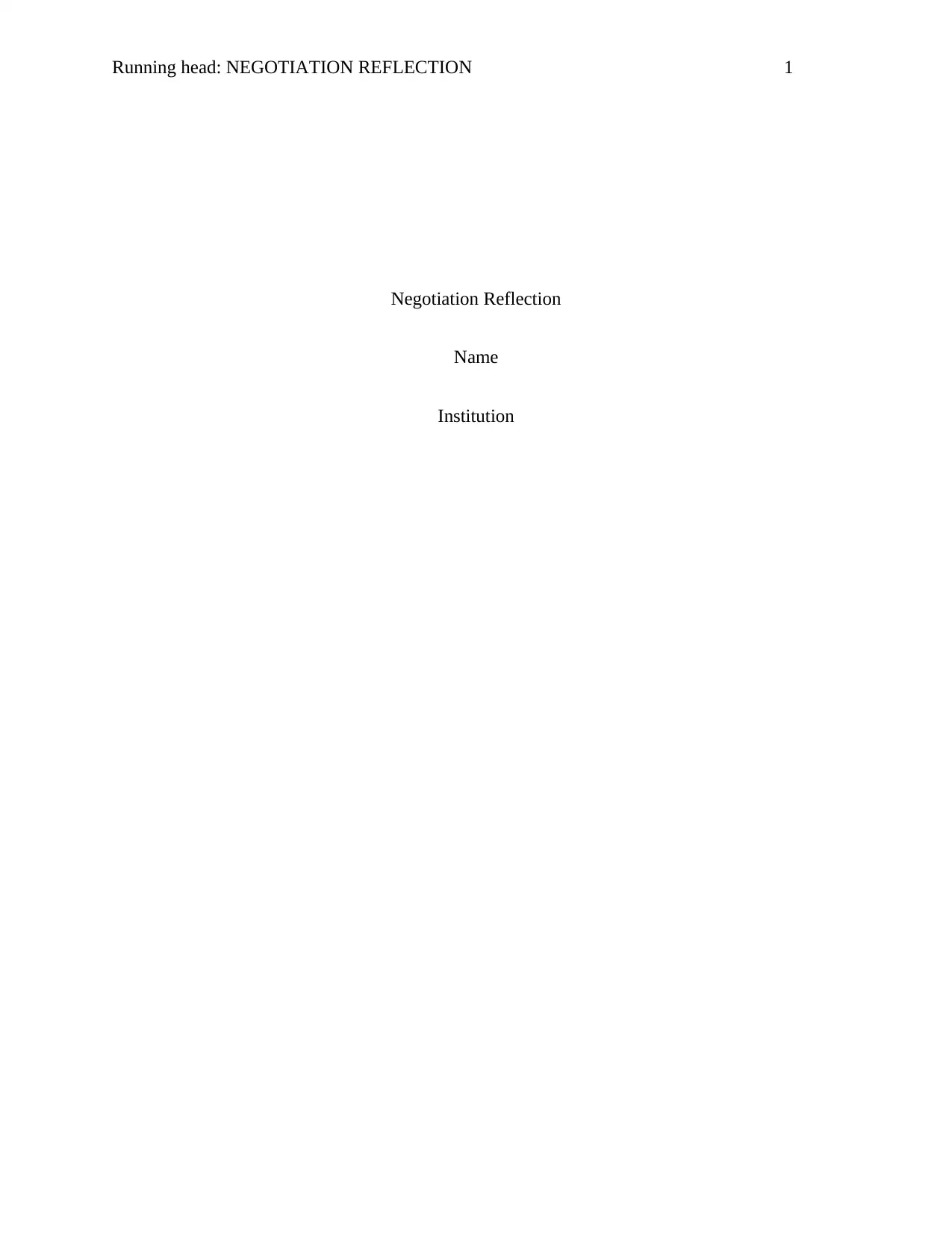
Running head: NEGOTIATION REFLECTION 1
Negotiation Reflection
Name
Institution
Negotiation Reflection
Name
Institution
Paraphrase This Document
Need a fresh take? Get an instant paraphrase of this document with our AI Paraphraser
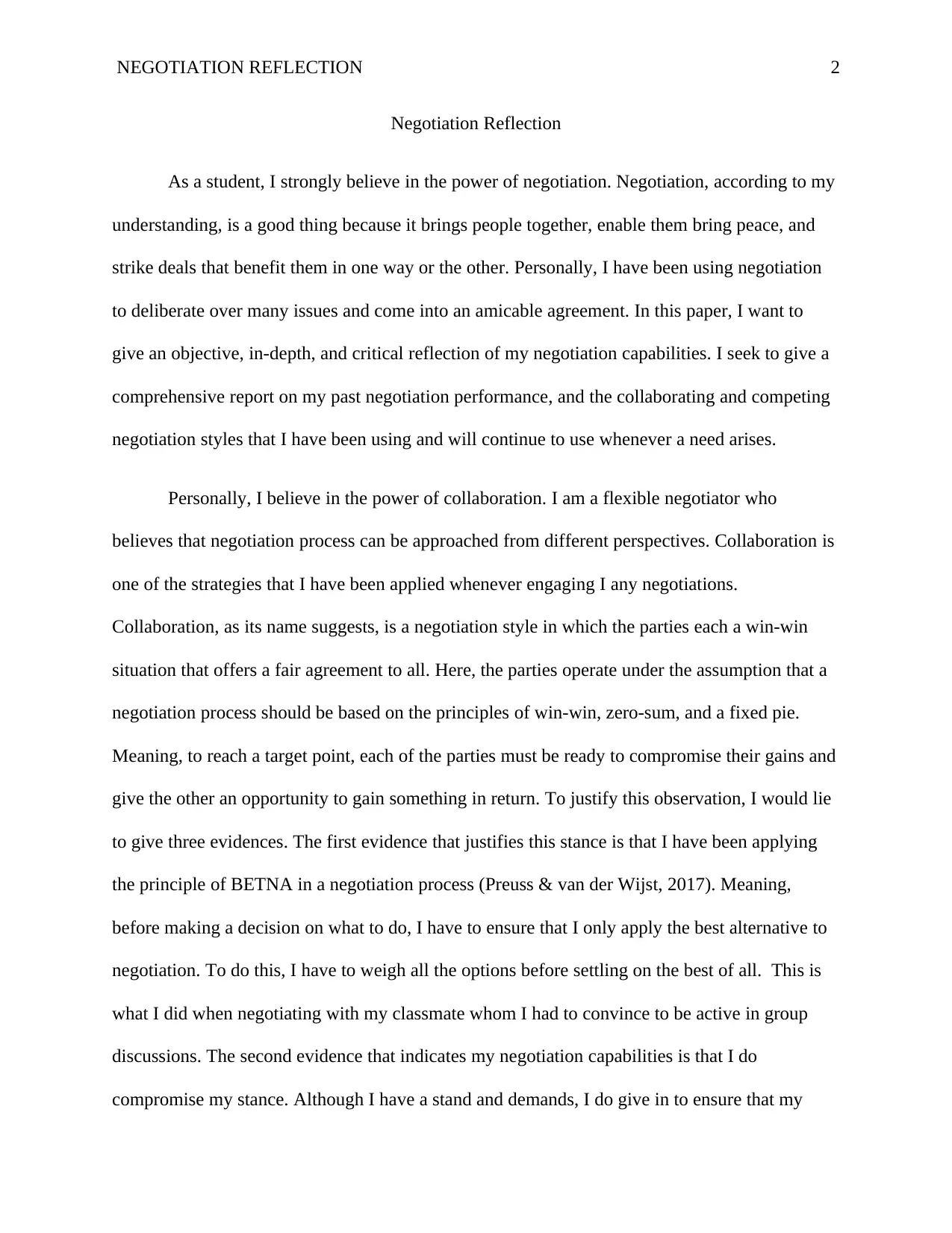
NEGOTIATION REFLECTION 2
Negotiation Reflection
As a student, I strongly believe in the power of negotiation. Negotiation, according to my
understanding, is a good thing because it brings people together, enable them bring peace, and
strike deals that benefit them in one way or the other. Personally, I have been using negotiation
to deliberate over many issues and come into an amicable agreement. In this paper, I want to
give an objective, in-depth, and critical reflection of my negotiation capabilities. I seek to give a
comprehensive report on my past negotiation performance, and the collaborating and competing
negotiation styles that I have been using and will continue to use whenever a need arises.
Personally, I believe in the power of collaboration. I am a flexible negotiator who
believes that negotiation process can be approached from different perspectives. Collaboration is
one of the strategies that I have been applied whenever engaging I any negotiations.
Collaboration, as its name suggests, is a negotiation style in which the parties each a win-win
situation that offers a fair agreement to all. Here, the parties operate under the assumption that a
negotiation process should be based on the principles of win-win, zero-sum, and a fixed pie.
Meaning, to reach a target point, each of the parties must be ready to compromise their gains and
give the other an opportunity to gain something in return. To justify this observation, I would lie
to give three evidences. The first evidence that justifies this stance is that I have been applying
the principle of BETNA in a negotiation process (Preuss & van der Wijst, 2017). Meaning,
before making a decision on what to do, I have to ensure that I only apply the best alternative to
negotiation. To do this, I have to weigh all the options before settling on the best of all. This is
what I did when negotiating with my classmate whom I had to convince to be active in group
discussions. The second evidence that indicates my negotiation capabilities is that I do
compromise my stance. Although I have a stand and demands, I do give in to ensure that my
Negotiation Reflection
As a student, I strongly believe in the power of negotiation. Negotiation, according to my
understanding, is a good thing because it brings people together, enable them bring peace, and
strike deals that benefit them in one way or the other. Personally, I have been using negotiation
to deliberate over many issues and come into an amicable agreement. In this paper, I want to
give an objective, in-depth, and critical reflection of my negotiation capabilities. I seek to give a
comprehensive report on my past negotiation performance, and the collaborating and competing
negotiation styles that I have been using and will continue to use whenever a need arises.
Personally, I believe in the power of collaboration. I am a flexible negotiator who
believes that negotiation process can be approached from different perspectives. Collaboration is
one of the strategies that I have been applied whenever engaging I any negotiations.
Collaboration, as its name suggests, is a negotiation style in which the parties each a win-win
situation that offers a fair agreement to all. Here, the parties operate under the assumption that a
negotiation process should be based on the principles of win-win, zero-sum, and a fixed pie.
Meaning, to reach a target point, each of the parties must be ready to compromise their gains and
give the other an opportunity to gain something in return. To justify this observation, I would lie
to give three evidences. The first evidence that justifies this stance is that I have been applying
the principle of BETNA in a negotiation process (Preuss & van der Wijst, 2017). Meaning,
before making a decision on what to do, I have to ensure that I only apply the best alternative to
negotiation. To do this, I have to weigh all the options before settling on the best of all. This is
what I did when negotiating with my classmate whom I had to convince to be active in group
discussions. The second evidence that indicates my negotiation capabilities is that I do
compromise my stance. Although I have a stand and demands, I do give in to ensure that my
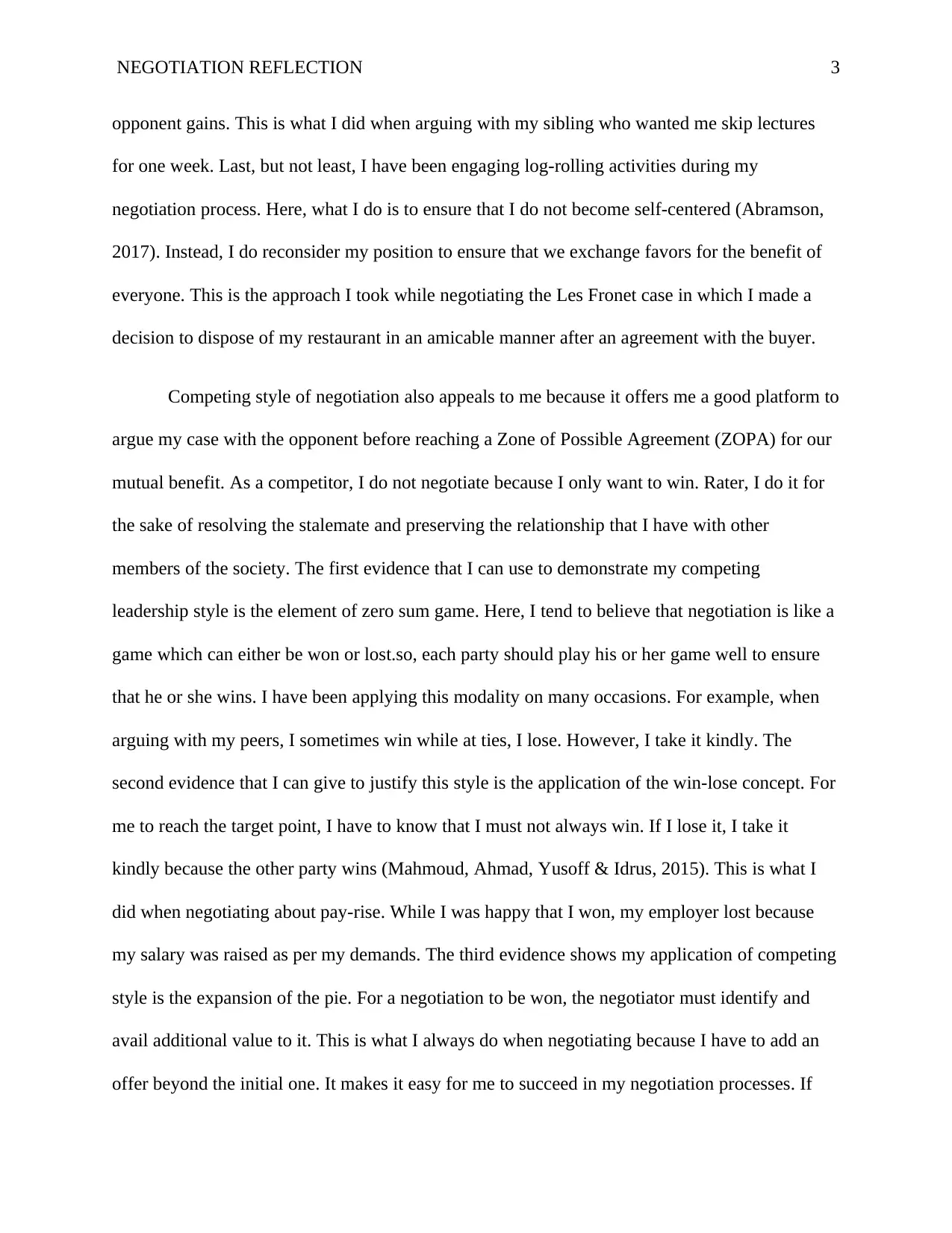
NEGOTIATION REFLECTION 3
opponent gains. This is what I did when arguing with my sibling who wanted me skip lectures
for one week. Last, but not least, I have been engaging log-rolling activities during my
negotiation process. Here, what I do is to ensure that I do not become self-centered (Abramson,
2017). Instead, I do reconsider my position to ensure that we exchange favors for the benefit of
everyone. This is the approach I took while negotiating the Les Fronet case in which I made a
decision to dispose of my restaurant in an amicable manner after an agreement with the buyer.
Competing style of negotiation also appeals to me because it offers me a good platform to
argue my case with the opponent before reaching a Zone of Possible Agreement (ZOPA) for our
mutual benefit. As a competitor, I do not negotiate because I only want to win. Rater, I do it for
the sake of resolving the stalemate and preserving the relationship that I have with other
members of the society. The first evidence that I can use to demonstrate my competing
leadership style is the element of zero sum game. Here, I tend to believe that negotiation is like a
game which can either be won or lost.so, each party should play his or her game well to ensure
that he or she wins. I have been applying this modality on many occasions. For example, when
arguing with my peers, I sometimes win while at ties, I lose. However, I take it kindly. The
second evidence that I can give to justify this style is the application of the win-lose concept. For
me to reach the target point, I have to know that I must not always win. If I lose it, I take it
kindly because the other party wins (Mahmoud, Ahmad, Yusoff & Idrus, 2015). This is what I
did when negotiating about pay-rise. While I was happy that I won, my employer lost because
my salary was raised as per my demands. The third evidence shows my application of competing
style is the expansion of the pie. For a negotiation to be won, the negotiator must identify and
avail additional value to it. This is what I always do when negotiating because I have to add an
offer beyond the initial one. It makes it easy for me to succeed in my negotiation processes. If
opponent gains. This is what I did when arguing with my sibling who wanted me skip lectures
for one week. Last, but not least, I have been engaging log-rolling activities during my
negotiation process. Here, what I do is to ensure that I do not become self-centered (Abramson,
2017). Instead, I do reconsider my position to ensure that we exchange favors for the benefit of
everyone. This is the approach I took while negotiating the Les Fronet case in which I made a
decision to dispose of my restaurant in an amicable manner after an agreement with the buyer.
Competing style of negotiation also appeals to me because it offers me a good platform to
argue my case with the opponent before reaching a Zone of Possible Agreement (ZOPA) for our
mutual benefit. As a competitor, I do not negotiate because I only want to win. Rater, I do it for
the sake of resolving the stalemate and preserving the relationship that I have with other
members of the society. The first evidence that I can use to demonstrate my competing
leadership style is the element of zero sum game. Here, I tend to believe that negotiation is like a
game which can either be won or lost.so, each party should play his or her game well to ensure
that he or she wins. I have been applying this modality on many occasions. For example, when
arguing with my peers, I sometimes win while at ties, I lose. However, I take it kindly. The
second evidence that I can give to justify this style is the application of the win-lose concept. For
me to reach the target point, I have to know that I must not always win. If I lose it, I take it
kindly because the other party wins (Mahmoud, Ahmad, Yusoff & Idrus, 2015). This is what I
did when negotiating about pay-rise. While I was happy that I won, my employer lost because
my salary was raised as per my demands. The third evidence shows my application of competing
style is the expansion of the pie. For a negotiation to be won, the negotiator must identify and
avail additional value to it. This is what I always do when negotiating because I have to add an
offer beyond the initial one. It makes it easy for me to succeed in my negotiation processes. If
⊘ This is a preview!⊘
Do you want full access?
Subscribe today to unlock all pages.

Trusted by 1+ million students worldwide
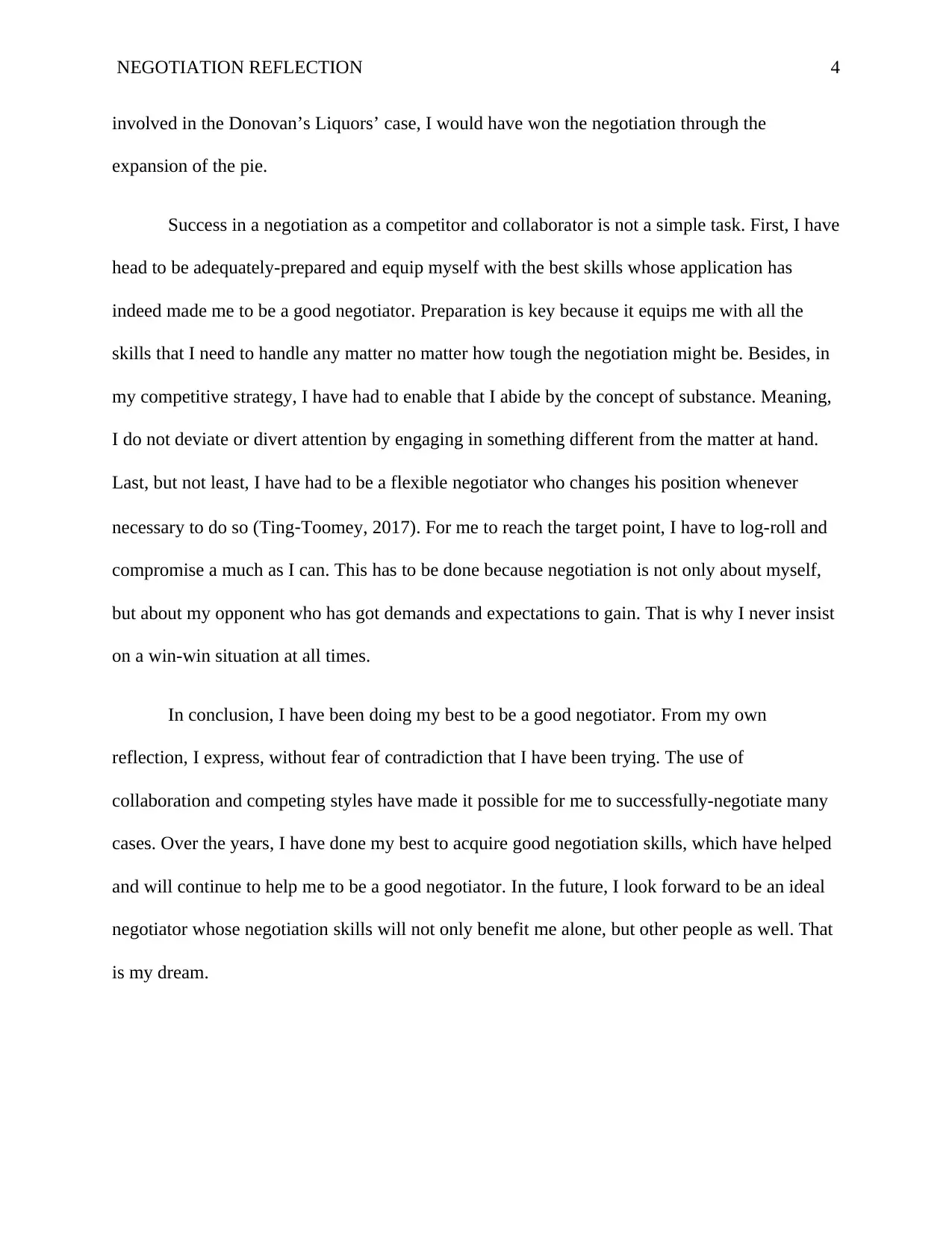
NEGOTIATION REFLECTION 4
involved in the Donovan’s Liquors’ case, I would have won the negotiation through the
expansion of the pie.
Success in a negotiation as a competitor and collaborator is not a simple task. First, I have
head to be adequately-prepared and equip myself with the best skills whose application has
indeed made me to be a good negotiator. Preparation is key because it equips me with all the
skills that I need to handle any matter no matter how tough the negotiation might be. Besides, in
my competitive strategy, I have had to enable that I abide by the concept of substance. Meaning,
I do not deviate or divert attention by engaging in something different from the matter at hand.
Last, but not least, I have had to be a flexible negotiator who changes his position whenever
necessary to do so (Ting‐Toomey, 2017). For me to reach the target point, I have to log-roll and
compromise a much as I can. This has to be done because negotiation is not only about myself,
but about my opponent who has got demands and expectations to gain. That is why I never insist
on a win-win situation at all times.
In conclusion, I have been doing my best to be a good negotiator. From my own
reflection, I express, without fear of contradiction that I have been trying. The use of
collaboration and competing styles have made it possible for me to successfully-negotiate many
cases. Over the years, I have done my best to acquire good negotiation skills, which have helped
and will continue to help me to be a good negotiator. In the future, I look forward to be an ideal
negotiator whose negotiation skills will not only benefit me alone, but other people as well. That
is my dream.
involved in the Donovan’s Liquors’ case, I would have won the negotiation through the
expansion of the pie.
Success in a negotiation as a competitor and collaborator is not a simple task. First, I have
head to be adequately-prepared and equip myself with the best skills whose application has
indeed made me to be a good negotiator. Preparation is key because it equips me with all the
skills that I need to handle any matter no matter how tough the negotiation might be. Besides, in
my competitive strategy, I have had to enable that I abide by the concept of substance. Meaning,
I do not deviate or divert attention by engaging in something different from the matter at hand.
Last, but not least, I have had to be a flexible negotiator who changes his position whenever
necessary to do so (Ting‐Toomey, 2017). For me to reach the target point, I have to log-roll and
compromise a much as I can. This has to be done because negotiation is not only about myself,
but about my opponent who has got demands and expectations to gain. That is why I never insist
on a win-win situation at all times.
In conclusion, I have been doing my best to be a good negotiator. From my own
reflection, I express, without fear of contradiction that I have been trying. The use of
collaboration and competing styles have made it possible for me to successfully-negotiate many
cases. Over the years, I have done my best to acquire good negotiation skills, which have helped
and will continue to help me to be a good negotiator. In the future, I look forward to be an ideal
negotiator whose negotiation skills will not only benefit me alone, but other people as well. That
is my dream.
Paraphrase This Document
Need a fresh take? Get an instant paraphrase of this document with our AI Paraphraser
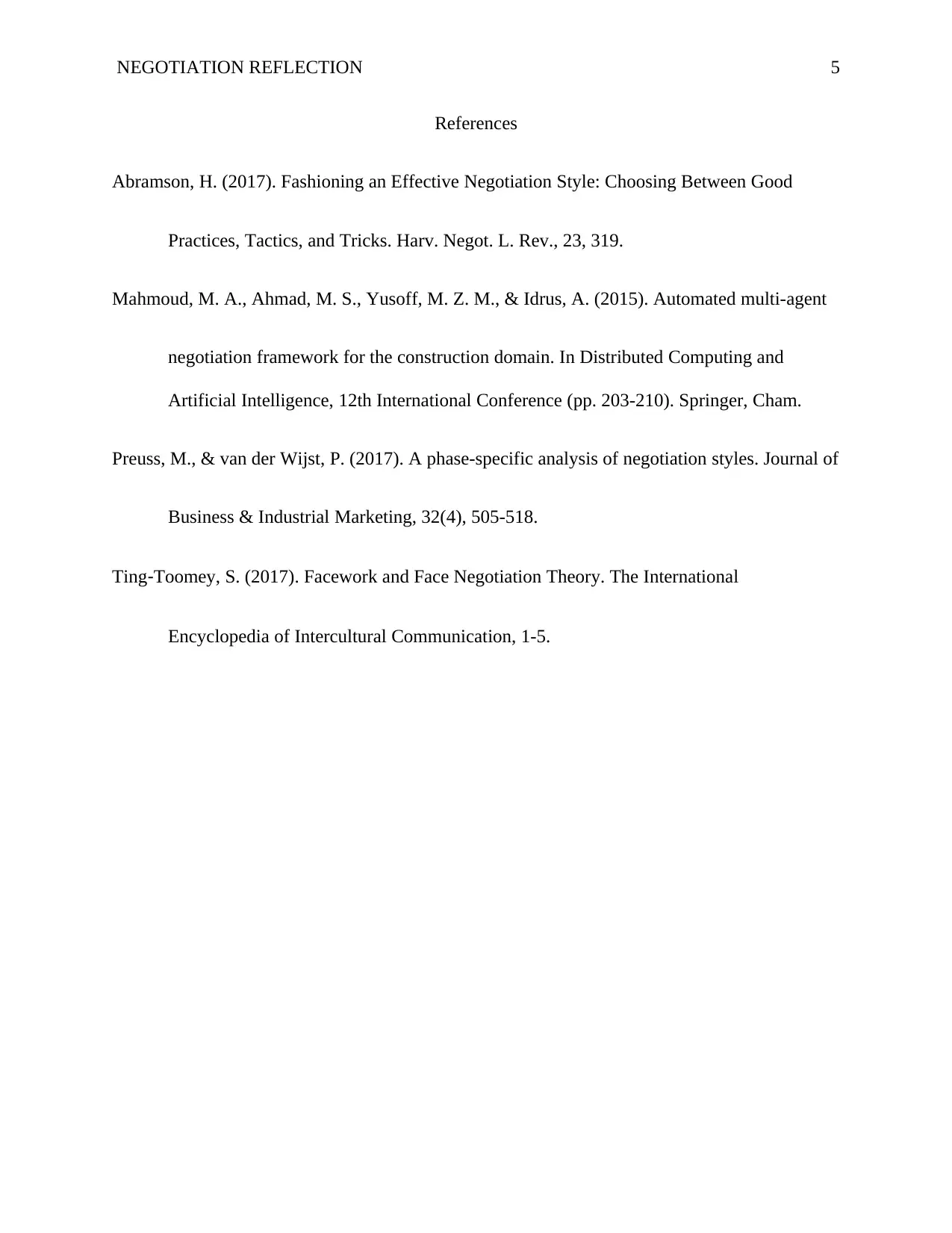
NEGOTIATION REFLECTION 5
References
Abramson, H. (2017). Fashioning an Effective Negotiation Style: Choosing Between Good
Practices, Tactics, and Tricks. Harv. Negot. L. Rev., 23, 319.
Mahmoud, M. A., Ahmad, M. S., Yusoff, M. Z. M., & Idrus, A. (2015). Automated multi-agent
negotiation framework for the construction domain. In Distributed Computing and
Artificial Intelligence, 12th International Conference (pp. 203-210). Springer, Cham.
Preuss, M., & van der Wijst, P. (2017). A phase-specific analysis of negotiation styles. Journal of
Business & Industrial Marketing, 32(4), 505-518.
Ting‐Toomey, S. (2017). Facework and Face Negotiation Theory. The International
Encyclopedia of Intercultural Communication, 1-5.
References
Abramson, H. (2017). Fashioning an Effective Negotiation Style: Choosing Between Good
Practices, Tactics, and Tricks. Harv. Negot. L. Rev., 23, 319.
Mahmoud, M. A., Ahmad, M. S., Yusoff, M. Z. M., & Idrus, A. (2015). Automated multi-agent
negotiation framework for the construction domain. In Distributed Computing and
Artificial Intelligence, 12th International Conference (pp. 203-210). Springer, Cham.
Preuss, M., & van der Wijst, P. (2017). A phase-specific analysis of negotiation styles. Journal of
Business & Industrial Marketing, 32(4), 505-518.
Ting‐Toomey, S. (2017). Facework and Face Negotiation Theory. The International
Encyclopedia of Intercultural Communication, 1-5.
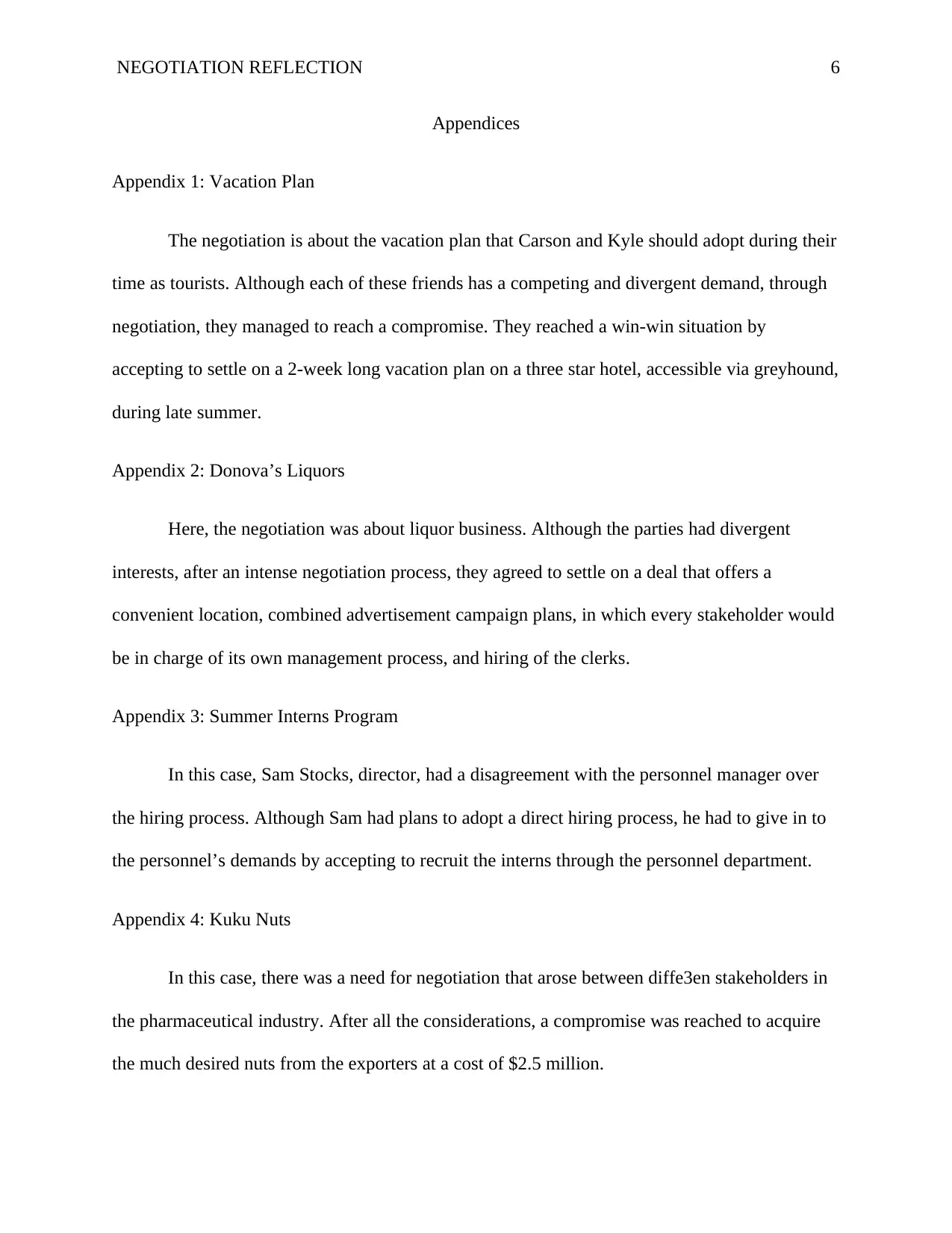
NEGOTIATION REFLECTION 6
Appendices
Appendix 1: Vacation Plan
The negotiation is about the vacation plan that Carson and Kyle should adopt during their
time as tourists. Although each of these friends has a competing and divergent demand, through
negotiation, they managed to reach a compromise. They reached a win-win situation by
accepting to settle on a 2-week long vacation plan on a three star hotel, accessible via greyhound,
during late summer.
Appendix 2: Donova’s Liquors
Here, the negotiation was about liquor business. Although the parties had divergent
interests, after an intense negotiation process, they agreed to settle on a deal that offers a
convenient location, combined advertisement campaign plans, in which every stakeholder would
be in charge of its own management process, and hiring of the clerks.
Appendix 3: Summer Interns Program
In this case, Sam Stocks, director, had a disagreement with the personnel manager over
the hiring process. Although Sam had plans to adopt a direct hiring process, he had to give in to
the personnel’s demands by accepting to recruit the interns through the personnel department.
Appendix 4: Kuku Nuts
In this case, there was a need for negotiation that arose between diffe3en stakeholders in
the pharmaceutical industry. After all the considerations, a compromise was reached to acquire
the much desired nuts from the exporters at a cost of $2.5 million.
Appendices
Appendix 1: Vacation Plan
The negotiation is about the vacation plan that Carson and Kyle should adopt during their
time as tourists. Although each of these friends has a competing and divergent demand, through
negotiation, they managed to reach a compromise. They reached a win-win situation by
accepting to settle on a 2-week long vacation plan on a three star hotel, accessible via greyhound,
during late summer.
Appendix 2: Donova’s Liquors
Here, the negotiation was about liquor business. Although the parties had divergent
interests, after an intense negotiation process, they agreed to settle on a deal that offers a
convenient location, combined advertisement campaign plans, in which every stakeholder would
be in charge of its own management process, and hiring of the clerks.
Appendix 3: Summer Interns Program
In this case, Sam Stocks, director, had a disagreement with the personnel manager over
the hiring process. Although Sam had plans to adopt a direct hiring process, he had to give in to
the personnel’s demands by accepting to recruit the interns through the personnel department.
Appendix 4: Kuku Nuts
In this case, there was a need for negotiation that arose between diffe3en stakeholders in
the pharmaceutical industry. After all the considerations, a compromise was reached to acquire
the much desired nuts from the exporters at a cost of $2.5 million.
⊘ This is a preview!⊘
Do you want full access?
Subscribe today to unlock all pages.

Trusted by 1+ million students worldwide

NEGOTIATION REFLECTION 7
Appendix 5: Les Flores
In this case, the restaurant owner had to engage in a negotiation with his buyers on the
right price at which to dispose of the facility. Although no client was willing to buy the property
at the floated price, negotiations had to take place to get the right buyer at the agreed price.
Appendix 5: Les Flores
In this case, the restaurant owner had to engage in a negotiation with his buyers on the
right price at which to dispose of the facility. Although no client was willing to buy the property
at the floated price, negotiations had to take place to get the right buyer at the agreed price.
1 out of 7
Related Documents
Your All-in-One AI-Powered Toolkit for Academic Success.
+13062052269
info@desklib.com
Available 24*7 on WhatsApp / Email
![[object Object]](/_next/static/media/star-bottom.7253800d.svg)
Unlock your academic potential
Copyright © 2020–2025 A2Z Services. All Rights Reserved. Developed and managed by ZUCOL.





